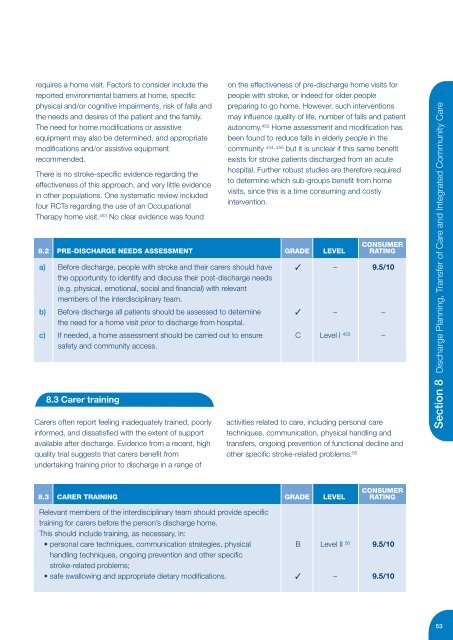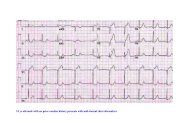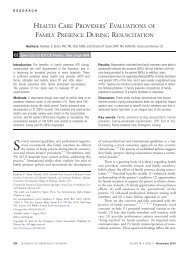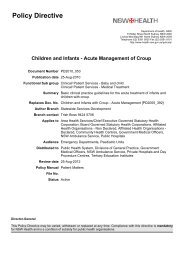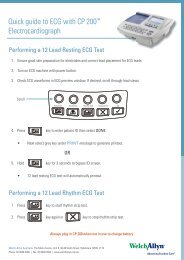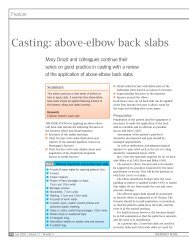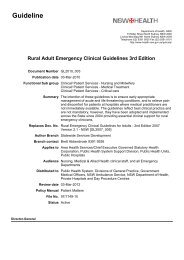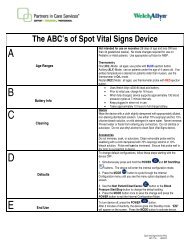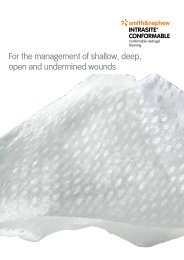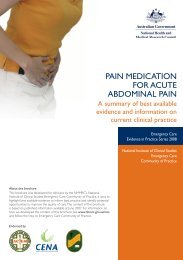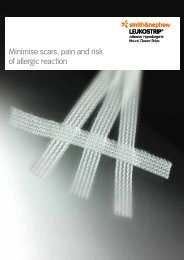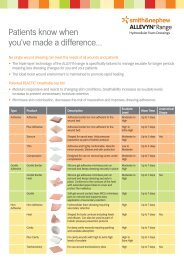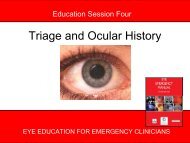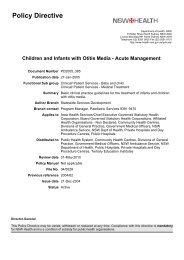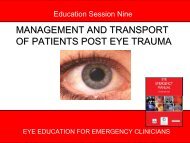Clinical Guidelines for Acute Stroke Management - Living on the EDge
Clinical Guidelines for Acute Stroke Management - Living on the EDge
Clinical Guidelines for Acute Stroke Management - Living on the EDge
Create successful ePaper yourself
Turn your PDF publications into a flip-book with our unique Google optimized e-Paper software.
equires a home visit. Factors to c<strong>on</strong>sider include <strong>the</strong><br />
reported envir<strong>on</strong>mental barriers at home, specific<br />
physical and/or cognitive impairments, risk of falls and<br />
<strong>the</strong> needs and desires of <strong>the</strong> patient and <strong>the</strong> family.<br />
The need <str<strong>on</strong>g>for</str<strong>on</strong>g> home modificati<strong>on</strong>s or assistive<br />
equipment may also be determined, and appropriate<br />
modificati<strong>on</strong>s and/or assistive equipment<br />
recommended.<br />
There is no stroke-specific evidence regarding <strong>the</strong><br />
effectiveness of this approach, and very little evidence<br />
in o<strong>the</strong>r populati<strong>on</strong>s. One systematic review included<br />
four RCTs regarding <strong>the</strong> use of an Occupati<strong>on</strong>al<br />
Therapy home visit. 453 No clear evidence was found<br />
<strong>on</strong> <strong>the</strong> effectiveness of pre-discharge home visits <str<strong>on</strong>g>for</str<strong>on</strong>g><br />
people with stroke, or indeed <str<strong>on</strong>g>for</str<strong>on</strong>g> older people<br />
preparing to go home. However, such interventi<strong>on</strong>s<br />
may influence quality of life, number of falls and patient<br />
aut<strong>on</strong>omy. 453 Home assessment and modificati<strong>on</strong> has<br />
been found to reduce falls in elderly people in <strong>the</strong><br />
community 454, 455 but it is unclear if this same benefit<br />
exists <str<strong>on</strong>g>for</str<strong>on</strong>g> stroke patients discharged from an acute<br />
hospital. Fur<strong>the</strong>r robust studies are <strong>the</strong>re<str<strong>on</strong>g>for</str<strong>on</strong>g>e required<br />
to determine which sub-groups benefit from home<br />
visits, since this is a time c<strong>on</strong>suming and costly<br />
interventi<strong>on</strong>.<br />
CONSUMER<br />
8.2 PRE-DISCHARGE NEEDS ASSESSMENT GRADE LEVEL RATING<br />
a) Be<str<strong>on</strong>g>for</str<strong>on</strong>g>e discharge, people with stroke and <strong>the</strong>ir carers should have ✓ – 9.5/10<br />
<strong>the</strong> opportunity to identify and discuss <strong>the</strong>ir post-discharge needs<br />
(e.g. physical, emoti<strong>on</strong>al, social and financial) with relevant<br />
members of <strong>the</strong> interdisciplinary team.<br />
b) Be<str<strong>on</strong>g>for</str<strong>on</strong>g>e discharge all patients should be assessed to determine ✓ – –<br />
<strong>the</strong> need <str<strong>on</strong>g>for</str<strong>on</strong>g> a home visit prior to discharge from hospital.<br />
c) If needed, a home assessment should be carried out to ensure C Level I 453 –<br />
safety and community access.<br />
8.3 Carer training<br />
Carers often report feeling inadequately trained, poorly<br />
in<str<strong>on</strong>g>for</str<strong>on</strong>g>med, and dissatisfied with <strong>the</strong> extent of support<br />
available after discharge. Evidence from a recent, high<br />
quality trial suggests that carers benefit from<br />
undertaking training prior to discharge in a range of<br />
activities related to care, including pers<strong>on</strong>al care<br />
techniques, communicati<strong>on</strong>, physical handling and<br />
transfers, <strong>on</strong>going preventi<strong>on</strong> of functi<strong>on</strong>al decline and<br />
o<strong>the</strong>r specific stroke-related problems. 56<br />
Secti<strong>on</strong> 8 Discharge Planning, Transfer of Care and Integrated Community Care<br />
CONSUMER<br />
8.3 CARER TRAINING GRADE LEVEL RATING<br />
Relevant members of <strong>the</strong> interdisciplinary team should provide specific<br />
training <str<strong>on</strong>g>for</str<strong>on</strong>g> carers be<str<strong>on</strong>g>for</str<strong>on</strong>g>e <strong>the</strong> pers<strong>on</strong>’s discharge home.<br />
This should include training, as necessary, in:<br />
• pers<strong>on</strong>al care techniques, communicati<strong>on</strong> strategies, physical B Level II 56 9.5/10<br />
handling techniques, <strong>on</strong>going preventi<strong>on</strong> and o<strong>the</strong>r specific<br />
stroke-related problems;<br />
• safe swallowing and appropriate dietary modificati<strong>on</strong>s. ✓ – 9.5/10<br />
53


